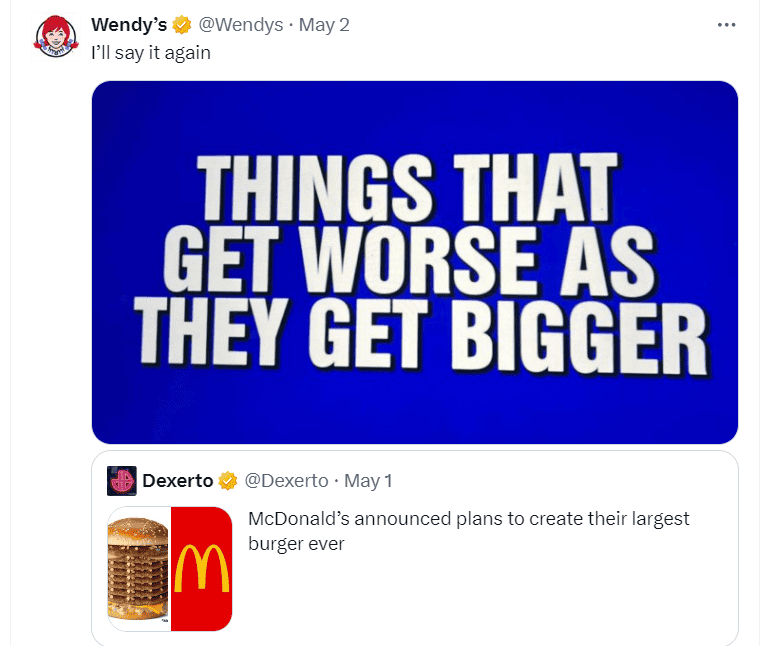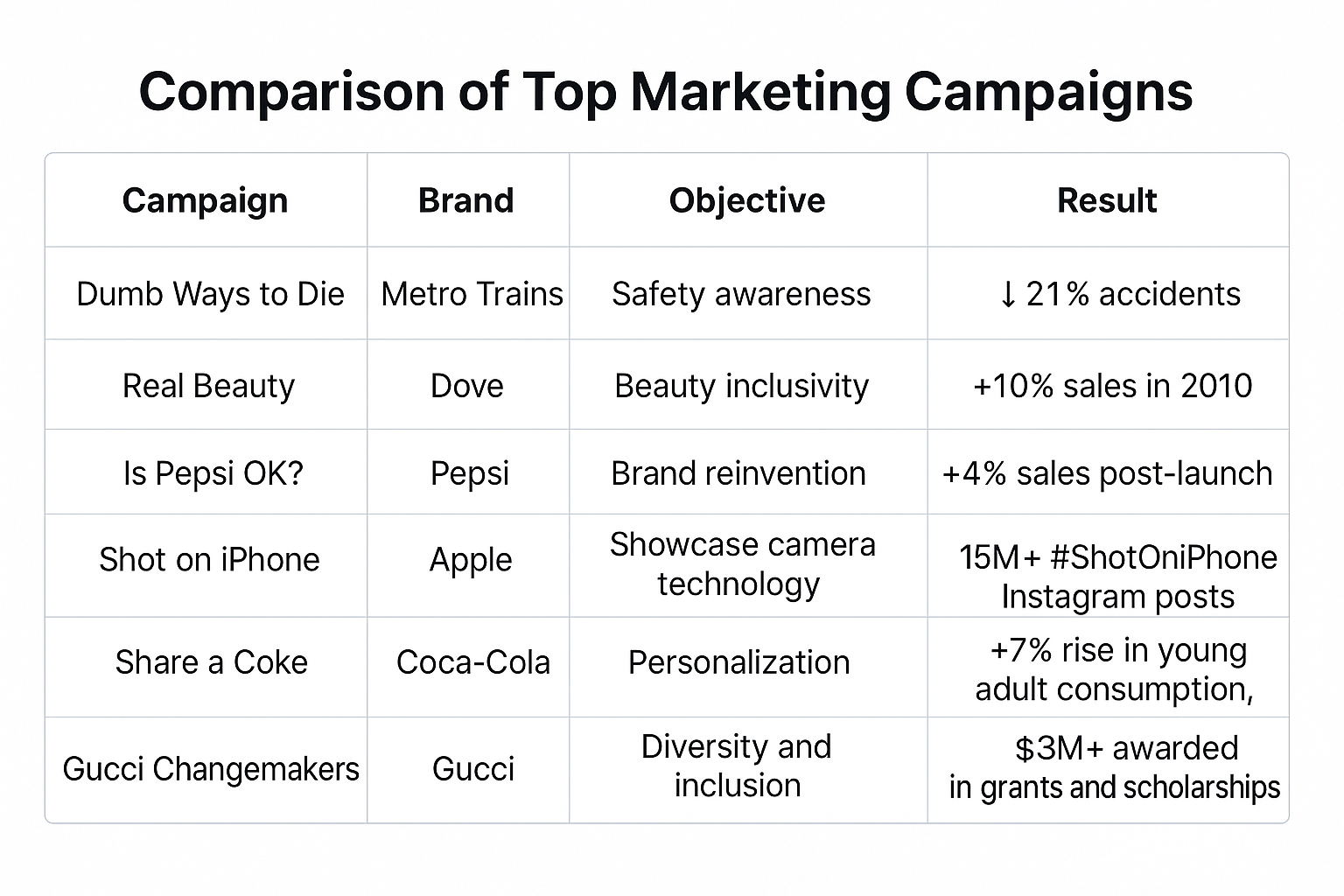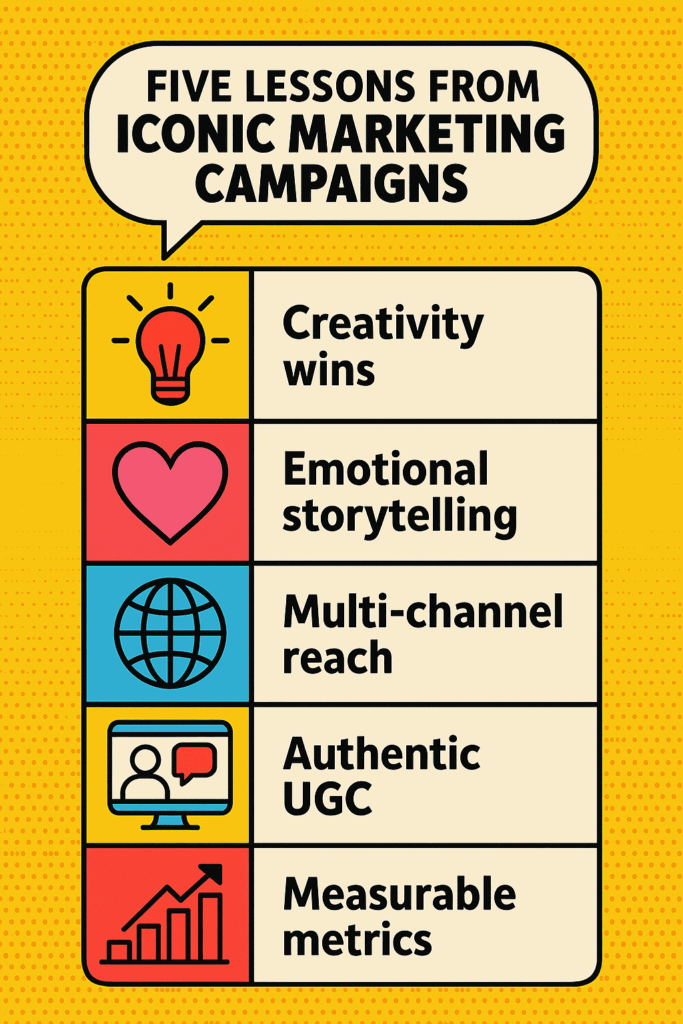The best marketing campaigns are those that do what the best are supposed to: deliver!
Consumers encounter numerous marketing campaigns daily, but only a few stand out as the best ones, leaving a lasting impression on their memory.
Marketing campaigns are crucial in educating the target audience, enhancing brand visibility, and driving conversions.
Only the brands that resonate most with customers or captivate the audience leveraging the best marketing campaigns will stick with them.
So, how do you create a great marketing campaign?
You do this by deploying digital marketing strategies that target your audience and using viral marketing techniques to gain engagement.
In this blog post, we have compiled a list of the best marketing campaigns to inspire you and dissect the strategies behind their triumphs.
Table of Contents
Understanding What Makes a Marketing Campaign Successful
So, what elements matter the most when you’re crafting a new marketing campaign? Let’s take a look.
Set clear objectives
Think of clear initiatives for your marketing campaign. Whether it’s aiming to boost sales by 20% or increasing brand awareness among a new demographic. Clear objectives provide focus and direction for your entire team.
The objectives to identify the best marketing campaigns include understanding your product. Conduct market research, set goals, establish key performance indicators (KPIs), and create an action plan.
Know your audience
A clear understanding of your target audience helps you set your marketing campaign on the right path.
Delve into customer demographics, behaviors, and preferences. What makes them tick? What solutions are they seeking? Personalize your campaign to fit these questions.
Customize your message to resonate with customer’s needs and aspirations. This will lead to better conversions.
A web analytics tool like Google Analytics can help you with this. Google Analytics provides insights into visitors’ demographics, behaviors, and preferences.
It tracks website interactions, allowing marketers to craft campaigns for specific audience segments.
Creativity and innovation
Creativity and innovation are about finding fresh angles, unexpected twists, and imaginative storytelling that spark curiosity and leave a lasting impression on your audience.
Minimalist Advertising: Clever Strategy or Passing Fad?
Create compelling content that resonates with the audience. You can do this by telling stories, using visuals, or creating engaging experiences.
Effective channels
Choosing the right channel to promote your product or services is crucial in launching successful marketing campaigns.
This involves analyzing which channel your audience spends the most time on. Whether they are scrolling through Instagram, tuning into podcasts, or attending industry events.
Measurable Results
It is crucial to track your marketing campaign’s performance and measure its progress against the established KPIs.
You should track website traffic, conversion rates, and customer engagement metrics.
They help you find deviations from the plan and make needed adjustments.
Diverse Industries, Diverse Strategies
From technology giants to fashion houses and food and beverage brands, each industry presents unique challenges and opportunities.
The Best Thanksgiving Marketing Ideas!
A customized approach works better for ad campaign development.
By examining the varied tactics employed by industry leaders, we can gain valuable insights into the ever-evolving marketing landscape.
Let’s delve into real-life examples of campaigns spanning diverse industries, showcasing successful ad campaigns.
These campaigns highlight product features, challenge industry perceptions, and leverage consumer insights.
Iconic Marketing Campaigns and Their Success Stories
In this section, we’ll explore some of the best marketing campaigns and what made them resonate.
7 Incredible Guerrilla Marketing Examples From Global Brands
1. Metro Trains “Dumb Ways to Die” campaign – Best Safety Campaign
Campaign overview
Metro Trains launched an iconic campaign that took social media by storm in 2012.
The “Dumb Ways to Die” campaign is a groundbreaking example of successful viral marketing.
Metro trains delivered a serious message about train safety using catchy music, adorable characters, and humor.
Objectives and goals
Dumb Ways to Die campaign’s primary goal was to raise awareness related to safety in metro trains. The advertisement specifically targeted younger demographics.
Cases of trespassing, reckless behavior around trains, and unsafe platform crossings were increasing, which led to the launch of this campaign.
Target audience
The Dumb Ways to Die campaign targeted the younger generation, including teenagers and young adults. The younger audience is more active on social media. They try to perform stunts on metro stations, violating safety rules.
The Dumb Ways to Die campaign went viral on digital platforms and reached the target audience.
Key strategies and tactics
- The campaign presented a serious message through animated characters and humor, which captured the audience’s attention.
- The campaign used successful viral marketing techniques. It used them to take over social media and digital channels, reach a wide audience, and encourage sharing.
- The music “Dumb Ways to Die” became a sensational hit among the audience, further spreading the safety message.
- The campaign created an emotional connection with viewers by showcasing the consequences of unsafe behavior around trains.
Outcome and impact
The “Dumb Ways to Die” campaign unexpectedly became a viral sensation. Metro Trains reported a remarkable increase in train safety and a reduction in risky behaviors around train stations. This campaign also received global recognition and numerous awards for its creativity.
Lessons learned
Innovation and creativity capture the audience, and the campaign should be designed according to the targeted segment.
Create shareable content designed for digital platforms to reach a wider audience.
2. Dove’s “Real Beauty” campaign – Best Beauty Campaign
Campaign overview
Dove’s “Real Beauty” campaign challenged the harmful societal norms of beauty and celebrated the diverse spectrum of beauty. This marketing campaign had an FBI sketch artist draw a woman based on her description and then again based on a stranger’s description.
The drawings turned out to be completely different and showcased that only a few women consider themselves beautiful. Dove’s campaign created a positive brand image.
Objectives and goals
Dove launched the “Real Beauty” campaign in 2004. This marketing campaign aimed to challenge beauty stereotypes and redefine societal standards. The primary goal was to build a positive self-image among women of all shapes, sizes, and backgrounds.
Target audience
Real Beauty campaign targeted women of all shapes, sizes, ages, and backgrounds to avoid being misrepresented by traditional beauty standards.
Dove realized many women felt insecure about their bodies. They saw a gap between what women wanted in beauty products and what the market delivered. The brand initiated this campaign to connect with consumers on a personal and emotional level.
Key strategies and tactics
- Dove employed various digital marketing strategies to amplify the campaign’s reach and impact. They asked women to share their photographs with the hashtag #mydovemessages on various social media platforms. The photos show women’s comfort with natural beauty while using Dove products.
- The brand got much media attention for its widespread message of celebrating natural beauty. It also got much praise for its message of inclusivity and empowerment.
- Dove successfully influenced the emotions of target consumers and set an example of marketing that contributed to society’s betterment.
Outcome and impact
Dove’s real beauty campaign remarkably impacted the brand’s reputation.
During 2006-10, Dove outshone its competitors by being conceived as more feminine than average by both men and women. The brand saw a 10% growth in 2010 compared to the previous year.
Additionally, the positive brand image helped Dove grow more in international markets.
Lessons learned
- The “Real Beauty” campaign delivered a valuable message about promoting authenticity and inclusivity in marketing. The brand drove sales and created positive social change by building meaningful connections with target consumers.
- Dove created a brand story by amplifying the voices of real people. It helped the brand resonate deeply with audiences worldwide.
3. “Is Pepsi OK?” campaign by Pepsi = Best Reinvention Campaign
Campaign Overview
“Is Pepsi OK” is one of the most innovative marketing campaigns. It confronted the stereotype that Pepsi is just an acceptable backup when the preferred choice isn’t available.
Pepsi created a television advertisement featuring Steve Carell, Cardi B, and Lil Jon. The advertisement featured a waiter asking a diner who ordered a Coke, “Is Pepsi OK?” and Carell clarifies that Pepsi is “More Than OK.”
The campaign aimed to position Pepsi as one of the top choices for consumers.
Objectives and goals
Pepsi’s goal in this campaign was to sell a product. They also wanted to change perceptions and reclaim their place in the beverage market.
Pepsi aimed to reshape this perception of being a secondary choice and position itself as a desirable beverage option.
Target audience
The marketers of the Pepsi campaign aimed to target consumers who had faced the age-old question of whether Pepsi was an acceptable alternative to their preferred beverage.
Pepsi also targeted younger demographics, including millennials and Gen Z, who are active on digital platforms. They fueled online conversation through hashtags like #MoreThanOK and #PepsiSuperBowl.
By targeting consumers who had questioned Pepsi’s adequacy as a beverage choice, the campaign aimed to shift perceptions.
Through the campaign, the brand reinforced Pepsi’s position as a desirable and legitimate option in consumers’ minds.
Key strategies and tactics
- Pepsi created an ad that catered to the question of why consumers don’t see Pepsi as their main drink. “Is Pepsi OK?” became a strong marketing campaign rather than a weak point. The campaign is an example of the best strategies that come from daring to challenge the status quo.
- Viral marketing techniques played a crucial role in amplifying the campaign’s reach. Pepsi initiated a domino effect of shares and likes through cleverly designed videos and memes, spreading its message far beyond traditional advertising channels.
- By partnering with celebrities and famous personalities who embody the spirit of the campaign, Pepsi solidified its position as a culturally relevant brand.
- Pepsi went beyond traditional marketing, such as ads, and engaged with audiences through multiple channels that created a more immersive campaign experience, driving organic reach and engagement.
Outcome and impact
The “Is Pepsi OK?” campaign yielded significant results in terms of brand perception and business outcomes.
Pepsi successfully shifted consumer perceptions and gained many new customers who preferred Pepsi rather than settling for it as an alternative.
This translated into tangible business outcomes, as Pepsi had a 4% increase in sales after the campaign.
The campaign generated substantial buzz and engagement on social media, with the hashtag #IsPepsiOK trending globally.
Pepsi solidified its position as a culturally relevant brand by igniting conversations and fostering community participation. This helped it strengthen its connection with consumers.
Lessons learned
- Pepsi transformed a simple question into a cultural phenomenon, leaving an indelible mark on the industry. Pepsi revitalized its brand image and set a precedent for future marketing endeavors.
- Addressing brand challenges with humor helped Pepsi engage with the audience directly and authentically. Celebrities and famous personalities in the campaign made it more relatable.
- Pepsi used a multi-channel campaign that included online and offline marketing to connect more with the audience.
Read also: How to Maximize Your Return on Ad Spend (ROAS) in 2025
4. Apple’s “Shot on iPhone” campaign – Best Photography Campaign
The Shot on iPhone campaign successfully marketed Apple’s iPhone quality. The brand used user-generated content by encouraging iPhone users to share their photos and videos captured with iPhones using the hashtag #ShotoniPhone.
By featuring real-life content from consumers, Apple highlighted the quality of iPhone cameras and the creativity of its users. The brand promoted authenticity and social proof around its product.
5. Coca-Cola’s “Share a Coke” campaign – Best Personalization Campaign
With its Share a Coke campaign, Coca-Cola tapped into the emotional aspect of sharing. The campaign involved printing popular names and phrases on Coke bottles and cans.
They encouraged consumers to find and share bottles with friends and loved ones.
The Coca-Cola campaign sparked social media conversations as people shared images of their personalized Coca-Cola bottles.
6. Gucci’s “Gucci Changemakers” campaign’ – Best Social Impact Campaign
Through the Gucci Changemakers campaign, Gucci aimed at promoting diversity and inclusivity within the fashion industry.
The campaign included mentorship programs, scholarships, and partnerships with non-profit organizations. It focused on empowering marginalized communities.
Gucci aimed to position itself as a socially responsible brand by addressing social issues and advocating for change.
The Best Marketing Campaigns Ever (2025 Summarized)
-
Metro Trains ‘Dumb Ways to Die’ (2025) – A real-time case study of a campaign that achieved a 21% reduction in train station incidents and amassed over 320 million YouTube views, demonstrating the power of humor and virality in public safety messaging.
-
Dove ‘Real Beauty’ (2025) – A real-time case study of a campaign that achieved 10% sales growth in 2010 by challenging beauty stereotypes and fostering authenticity and inclusivity.
-
Pepsi ‘Is Pepsi OK?’ (2025) – A real-time case study of a campaign that achieved a 4% increase in sales in the weeks following its launch, flipping a perceived weakness into a bold brand statement.
-
Apple ‘Shot on iPhone’ (2025) – A real-time case study of a campaign that achieved a 24% increase in iPhone sales and generated over 15 million #ShotOniPhone posts, leveraging user-generated content to showcase product quality.
-
Coca-Cola ‘Share a Coke’ (2025) – A real-time case study of a campaign that achieved a 7% increase in consumption among young adults and a 2% rise in U.S. sales, reversing a decade-long decline through personalization and emotional connection.
-
Gucci ‘Gucci Changemakers’ (2025) – A real-time case study of a campaign that awarded over $3 million in scholarships and grants, empowering more than 90 students and non-profit partners to drive diversity and social impact in the fashion industry.
Comparison of top marketing campaigns by brand, objective, channel, and key result.
The Role of Digital Transformation in Modern Marketing Campaigns
The rise of digital platforms has allowed marketers to leverage new technologies and channels. They like to engage with their target audiences in more personalized and impactful ways.
One key goal of digital marketing transformation is to boost sales. This is done better by reaching target customers. The role of digital transformation is to use technology to continuously modify digital models and their operations.
Let’s explore how digital transformation has influenced modern marketing campaigns, along with examples of digital-first or digital-only campaigns.
Data-driven insights
With the help of digital platforms marketers gain access to vast amounts of data. This data can be used to gain valuable insights into consumer behavior, preferences, and trends.
Data-driven insights enable marketers to create a more structured campaign for targeted audience segments. For example, Netflix utilizes data analytics to recommend personalized content to its subscribers based on their viewing history, preferences, and demographics.
Social media marketing
Social media platforms have become integral to marketing campaigns, offering unparalleled reach and engagement opportunities.
Through platforms like Facebook, Instagram, X (formerly Twitter), and LinkedIn, brands can interact directly with consumers. This allows them to build communities and gain brand loyalty.
One notable example is Wendy’s X account, known for its humorous and engaging posts. It has garnered widespread attention and increased brand awareness.

Virtual reality (VR) and augmented reality (AR)
Advancements in VR and AR technologies have opened up new possibilities for immersive and interactive marketing experiences. Brands can create virtual tours, product demonstrations, or branded AR filters to engage consumers in memorable ways.
For example, IKEA offers an AR app that allows users to visualize how furniture would look in their homes before purchasing. It enhances the overall online shopping experience.
Analyzing the Impact of Social Media on Campaign Success
- Social media platforms have revolutionized marketing campaigns. They offer opportunities to reach vast audiences with minimal cost. They have indeed become powerful tools for viral marketing campaigns.
- Influencers have a strong hold on social media. People see social media influencers as authentic and relatable. Their endorsement of products or campaigns can bring much attention and engagement.
- Campaigns often create unique hashtags for tracking, engagement, and user-generated content aggregation. Hashtags serve as digital signposts, enabling users to discover content related to specific topics or campaigns.
- User-generated content (UGC) humanizes campaigns, making them more relatable and trustworthy to audiences. UGC involves content created by users, not brands, which brings authenticity.
- Various metrics and tools help monitor campaigns. They track their impact on desired outcomes, such as website visits, sign-ups, or sales. Engagement metrics, like likes, shares, comments, and retweets, provide insights into the reach and resonance of social media campaigns.
Challenges in Running a Successful Marketing Campaign
Many challenges might affect your marketing campaign; let’s navigate through various challenges that can impact its effectiveness.
Budget constraints
Marketers often encounter limitations regarding budget allocation for campaigns. To mitigate this challenge, prioritize channels with the highest ROI potential. Focus on cost-effective digital marketing strategies such as content marketing, social media advertising, and email marketing.
Changing consumer behavior
Consumer behavior constantly evolves and is influenced by trends, socioeconomic factors, and technological advancements. Marketers need to conduct regular market research. They should utilize data analytics to understand shifting preferences and anticipate future trends.
Using an agile approach can help marketers to gain insight into changing consumer behaviors. They can experiment with new strategies and personalize marketing techniques to resonate with target audiences.
Measurement and ROI tracking
Measuring the success of marketing campaigns and demonstrating ROI can be challenging.
Install robust analytics and attribution models to track key performance indicators (KPIs). Set clear objectives and establish benchmarks for measuring success.
Keeping up with technology
Technology is a major aspect of marketing, from automation tools to data analytics platforms.
However, the rapid pace of technological innovation can be overwhelming for marketers. Address this challenge and keep your team updated with the latest tools and techniques. Additionally, invest in ongoing training and development programs to stay ahead in the game.
For a deeper dive, check out our guide to ‘Key Marketing Trends’
Simple Steps To Plan Your Marketing Campaign
Planning a successful marketing campaign requires careful consideration and strategic execution. Use these outlined steps as a guide for planning your next marketing campaign.
Let’s help you plan your successful marketing campaign effectively.
Define your goals
Clearly outline what you want to achieve with your marketing campaign. You should know the “why” behind your campaign. Whether it’s increasing brand awareness, generating leads, boosting sales, or launching a new product. You should have specific goals that will guide your strategy.
Know your audience
Conduct thorough market research to understand your target audience’s demographics, preferences, behaviors, and pain points.
This information will help you personalize your messaging and choose the most appropriate channels to reach them. Make sure to gather information related to company size, industry, and preferred media channels.
Set your budget
Determine how much you’re willing to invest in your marketing campaign. Consider costs for advertising, content creation, design, tools, and personnel. Allocate your budget based on the channels that will yield the best results for your target audience.
Craft your message
Develop a compelling message that resonates with your target audience and aligns with your brand identity. Communicate the value proposition of your product or service and highlight what sets you apart from competitors.
Share customer testimonials, published case studies, and highlighted pain points that need to be addressed. This will help you to relate your message to the audience and build credibility.
Develop high-quality content and assets that support your message and engage your audience. This could include blog posts, videos, infographics, social media posts, email newsletters, landing pages, and ads.
Choose your channels
Select the marketing channels that will effectively reach your target audience and align with your campaign goals. Options include social media, email marketing, content marketing, PPC advertising, SEO, influencer marketing, and more.
Develop a timeline
Create a timeline that outlines your campaign’s key milestones and deadlines, from planning and content creation to launch and post-campaign analysis. Make sure to account for any seasonality or timely events relevant to your campaign.
Execute your campaign
After planning, personalizing, and researching, you are set to execute your campaign. Implement your marketing activities according to your plan, ensuring all elements are coordinated and executed seamlessly. Monitor your campaign’s real-time performance and adjust as needed to optimize results.
Measure and analyze results
Track your marketing campaign’s performance using relevant metrics and KPIs, such as website traffic, conversion rates, engagement levels, and ROI. Analyze the data to identify what worked well and areas for improvement.
Revise your campaign strategies and tactics for future campaigns based on your analysis. Don’t forget to take note of customer feedback as well. Incorporate learnings from past campaigns to continuously improve your marketing efforts and achieve better results over time.
Conclusion
Successful marketing campaigns are crafted with precision.
They combine creativity, data-driven strategies, and an understanding of the target audience. From compelling storytelling to leveraging the power of social media, the best marketing campaigns resonate with consumers on an emotional level.
Marketers can personalize their messages effectively by analyzing consumer behavior and market trends, ensuring relevance and impact.
Remember, the best marketing campaigns exude authenticity and consistency which are key to building trust and credibility. So, as you start your marketing campaign journey, use these insights.
Try new ideas to come up with the best marketing campaigns and stay adaptable to get great results.
Want step‑by‑step help launching your own best marketing campaign? Schedule a free demo today!
Iconic campaigns include Metro Trains’ Dumb Ways to Die, Dove’s Real Beauty, Pepsi’s Is Pepsi OK?, Apple’s Shot on iPhone, Coca-Cola’s Share a Coke, Gucci Gucci Changemakers – plus 2025 additions.
The best marketing campaigns set clear objectives, know their audience, leverage creativity, choose the right channels, and measure results against key metrics.
By printing individual names on bottles, Coca-Cola created emotional connections that boosted consumption among young adults and reversed sales decline.
UGC like Apple’s #ShotOniPhone builds authenticity and social proof by showcasing real customers, driving trust and organic reach.
Humor in safety messaging exemplified by Metro Trains’ Dumb Ways to Die captures attention, encourages sharing, and drives behavior change.


